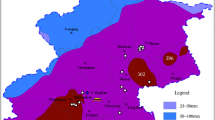Abstract
The dynamic observation data on groundwater level and water quality were obtained from rain gardens #2 and #3 from May to October 2016. The water balance method and 2D numerical simulation of variable saturation zone were used to calculate rainfall infiltration recharge coefficient, water supply, and evaporative discharge of rain garden. These parameters were used to simulate and explore the impact of rainfall infiltration in rain gardens on groundwater level and water quality. The groundwater depth of rain gardens was mainly affected by the concentrated infiltration of rainfall. The variation range of groundwater depth was approximately 4.298 ± 0.031 mm for J1, 3.9364 ± 0.097 mm for J2, and 4.0958 ± 0.064 mm for J3, and the specific yield was 0.208. Groundwater quality was naturally attenuated and would not threaten the safety of groundwater at a certain scale. Visual MODFLOW was used to simulate groundwater flow and conduct parameter sensitivity analysis to determine the main influencing factors of garden groundwater level change. Results showed that rainfall recharge was crucial to module sensitivity.










Similar content being viewed by others
References
Arnold JG, Muttiah RS, Srinivasan R, Allen PM (2000) Regional estimation of base flow and groundwater recharge in the Upper Mississippi River basin. J Hydrol 227:21–40
Crosbie R S, Binning P, Kalma J D (2005) A time series approach to inferring groundwater recharge using the water table fluctuation method. Water Resour Res 41:1-8
Forrer R, Kasteel M, Flury H (1999) Flühler longitudinal and lateral dispersion in an unsaturated field soil. Water Resou Res 35:3049–3060
Fan Y, Zhao ZG, Huang X, Jia LJ, Lu HY (2015) Numerical simulation of groundwater in Tenglong terrace based on Visual MODFLOW. J Water Resour Archit Eng 13:195–200 in Chinese
Gerla PJ (1992) The relationship of water-table changes to the capillary fringe, evapotranspiration, and precipitation in intermittent wetlands. Wetlands 12:91–98
Guo C, Li JK, Li HE, Ma MH, Zhang B, Zhao RS (2017) Rainwater garden concentration infiltration on the groundwater level and water quality. J Hydroelectr Eng 36:49–60 in Chinese
Jia ZH, Wu SR, Tang SC, Luo Z, Xu Q, Shao ZX, Ma XY (2018) Influences of focused recharge from rain gardens on groundwater level and water quality. Adv Water Sci 29:221–229
Jin YL, Qin JA (2016) Research on numerical simulation of contaminant transportion in groundwater and its application review. Ground Water 38:21–23 in Chinese
Lu YT, Tang CY, Chen JY, Chen JH (2015) Groundwater Recharge and Hydrogeochemical Evolution in Leizhou Peninsula, China. J Chem 2015:1-12
Li JQ, Xiang LL, Mao K, Li BH, Li HY, Che W (2010) Case analysis of rainwater garden soil infiltration disposal roof runoff. China Water Wastewater 26:129–133 in Chinese
Loheide SP, Butler JJ, Gorelick SM (2005) Estimation of groundwater consumption by phreatophytes using diurnal water table fluctuations: a saturated-unsaturated flow assessment. Water Resour Res 41:372–380
MACHUSICK M, WELLKER A, TRAVER R (2011) Groundwater mounding at a storm-water infiltration BMP. J Irrig Drain E-asce 137:154–160
Morris MD (1991) Factorial sampling plans for preliminary computational experiments. Technometrics 33:161–174
Phillips IR (2006) Modelling water and chemical transport in large undisturbed soil cores using HYDRUS-2D. Soil Res 44:27–34
Rantz SE (1982) Measurement and computation of streamflow: volume 1. Measurement of stage and discharge. Geol Surv Water-Supply Pap 1:211-226
Raj MS, Prabhakar S (2016) Groundwater system simulation and management using Visual MODFLOW and Arc-SWAT. International Conference 5:29–35
Schilling KE, Kiniry JR (2007) Estimation of evapotranspiration by reed canary grass using field observations and model simulations. J Hydrol 337:356–363
Scholz M, Grabowiecki P (2007) Review of permeable pavement systems. Build Environ 42:3830–3836
Sharifan RA, Roshan A, Aflatoni M, Jahedi A, Zolghadr M (2010) Uncertainty and sensitivity analysis of SWMM model in computation of manhole water depth and subcatchment peak flood. Procedia Soc Behav Sci 2:7739–7740
Tang SC (2016) Study on regulation of rain - fed and flood runoff by small and medium green infrastructure in Sponge City. Dissertation. Xi’an University of Technology., Xi’an China. (in Chinese)
Ting CS, Kerh T, Liao CJ (1998) Estimation of groundwater recharge using the chloride mass-balance method, Pingtung Plain, Taiwan. Hydrogeol J 6:282–292
Van RM (2007) Water localisation and reclamation: steps towards low impact urban design and development. J Environ Manag 83:437
Watson A, Miller J, Fleischer M, Clercq WD (2018) Estimation of groundwater recharge via percolation outputs from a rainfall/runoff model for the Verlorenvlei estuarine system, west coast, South Africa. J Hydrol 558:238–254
Wu DJ, Zhan SZ, Li YH, Tu MZ, Zu JY, Guo YY (2016) New trend and practice of Sponge City with Chinese characteristics. China Soft Science 1:79–97 (in Chinese)
Yang H, Dick WA, Mccoy EL, Phelan PL, Grewal PS (2013) Field evaluation of a new biphasic rain garden for storm water flow management and pollutant removal. Eco Eng 54:22–31
Yu KJ, Li DH, Yuan H, Fu W, Qiao Q, Wang SS (2015) Theory and practice of “Sponge City”. City planning 39:26–36 in Chinese
Zhu RR, Zheng HX, Liu CM (2010) Changes of groundwater recharge and discharge in water shed of the Loess Plateau. Sci Geogr sci 30:108–112.( in Chinese)
Zhai YZ, Wang JS, Su XS (2010) Parameter sensitivity analysis in groundwater numerical simulation. People’s Yellow River 32:99–101 (in Chinese)
Zimmer CA, Heathcote IW, Whiteley HR, Schroter H (2007) Low impact development practices for storm water: implications for urban hydrology. Can Water Resour J 32:193–212
Funding
This research was financially supported by the National Natural Science Foundation of China (51879215), the Key Research and Development Project of Shaanxi Province (2017ZDXM-SF-073), and the Open Foundation of Institute of Water Resources and Hydro-electric Engineering of Xi’an University of Technology (2016ZZKTZ-30).
Author information
Authors and Affiliations
Corresponding author
Additional information
Responsible editor: Marcus Schulz
Publisher’s note
Springer Nature remains neutral with regard to jurisdictional claims in published maps and institutional affiliations.
Rights and permissions
About this article
Cite this article
Li, J., Li, F., Li, H. et al. Analysis of rainfall infiltration and its influence on groundwater in rain gardens. Environ Sci Pollut Res 26, 22641–22655 (2019). https://doi.org/10.1007/s11356-019-05622-z
Received:
Accepted:
Published:
Issue Date:
DOI: https://doi.org/10.1007/s11356-019-05622-z




